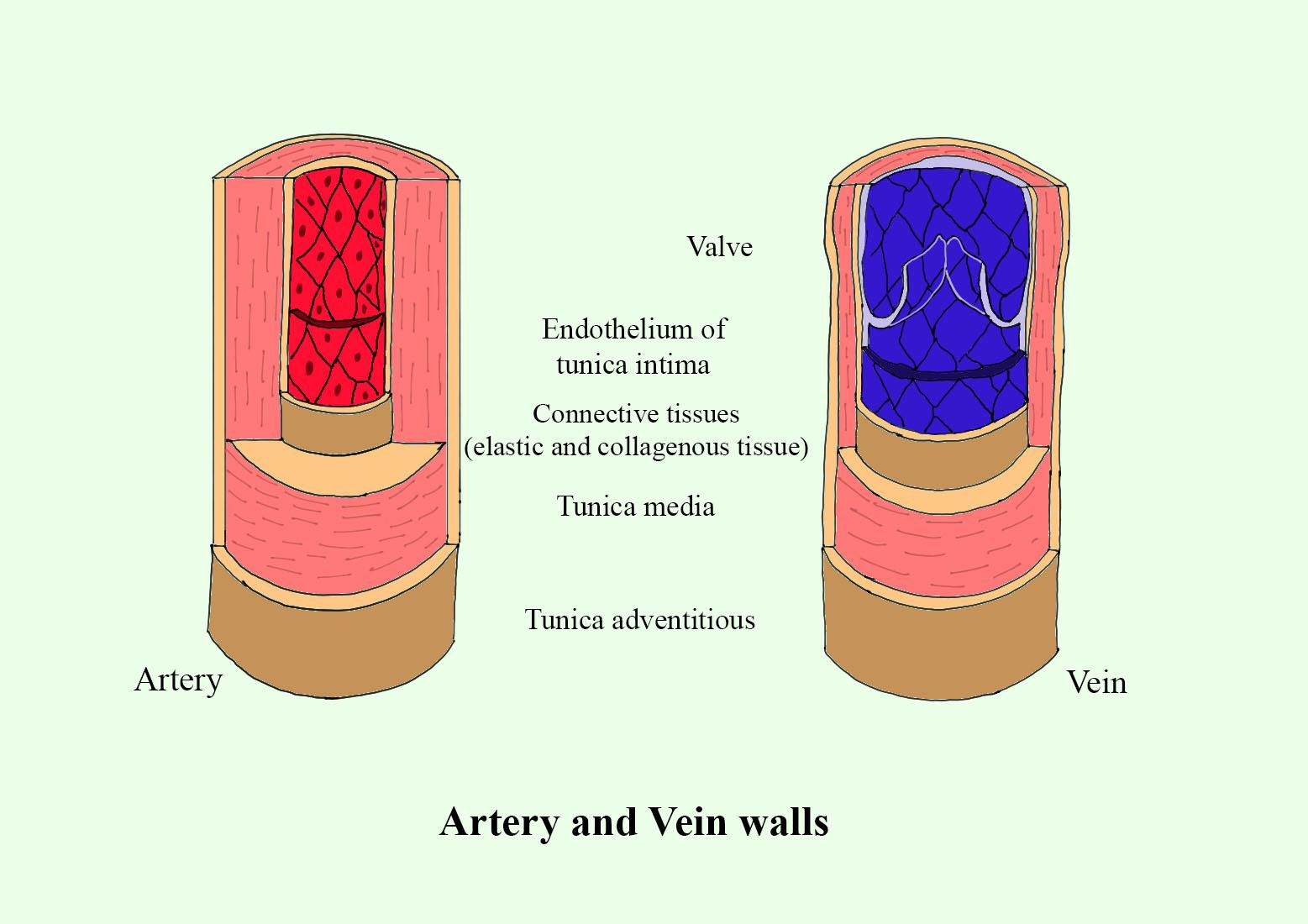
The main difference in the structure of arteries and veins is in
(a) Tunica interna, made up of simple squamous epithelium
(b) Tunica media
(c) Tunica externa
(d) Tunica adventitia
Answer
567.3k+ views
Hint: Muscular layer in one of the blood vessels is much thicker because it is surrounded by two elastic laminae. Tunica adventitia is an additional layer that is present between the muscular layer and fibrous connective tissue layer
Complete step by step answer:
The walls of arteries and veins are made up of three layers namely tunica externa/ adventitia, tunica media, and tunica interna. Along with the above layers arteries and arterioles have two elastic laminae on either side of tunica media. This muscular layer is much thicker in arteries than in veins.
So, the correct answer is ‘Tunica media’.
Additional information:
- Blood is circulated to various parts of the body by arteries and veins.
- Arteries carry oxygenated blood from the heart to various organs and tissues
- Veins carry deoxygenated blood from various organs to the heart
- The blood vessels that carry arteries and veins are called capillaries
- Walls of arteries and veins are made up of three layers i. tunica externa/tunica adventitia ii. tunica media and iii. tunica interna.

- Tunica externa or tunica adventitia is made up of fibrous connective tissue
- Tunica media is made up of smooth muscle
- Tunica interna is made up of endothelium and basement membrane.
- Tunica adventitia is the additional layer present between the tunica media and tunica externa. It helps in structural stability to the arteries and veins.
- Arteries and arterioles contain two elastic laminae on either side of the muscular layer i.e, tunica media. This elastic lamina is not found in the walls of veins.
- Tunica media is much thicker in arteries than in veins
- Endothelial layer in veins is double folded to form valves which direct the blood to the heart
Note: Some of the differences between arteries and veins are:
- Arteries are bright red in color whereas veins are dark red in color
- lumen is narrow in arteries and wide in veins
- Arteries are non-valvular, veins are valvular
- Arteries end in capillaries and veins start with capillaries.
Complete step by step answer:
The walls of arteries and veins are made up of three layers namely tunica externa/ adventitia, tunica media, and tunica interna. Along with the above layers arteries and arterioles have two elastic laminae on either side of tunica media. This muscular layer is much thicker in arteries than in veins.
So, the correct answer is ‘Tunica media’.
Additional information:
- Blood is circulated to various parts of the body by arteries and veins.
- Arteries carry oxygenated blood from the heart to various organs and tissues
- Veins carry deoxygenated blood from various organs to the heart
- The blood vessels that carry arteries and veins are called capillaries
- Walls of arteries and veins are made up of three layers i. tunica externa/tunica adventitia ii. tunica media and iii. tunica interna.

- Tunica externa or tunica adventitia is made up of fibrous connective tissue
- Tunica media is made up of smooth muscle
- Tunica interna is made up of endothelium and basement membrane.
- Tunica adventitia is the additional layer present between the tunica media and tunica externa. It helps in structural stability to the arteries and veins.
- Arteries and arterioles contain two elastic laminae on either side of the muscular layer i.e, tunica media. This elastic lamina is not found in the walls of veins.
- Tunica media is much thicker in arteries than in veins
- Endothelial layer in veins is double folded to form valves which direct the blood to the heart
Note: Some of the differences between arteries and veins are:
- Arteries are bright red in color whereas veins are dark red in color
- lumen is narrow in arteries and wide in veins
- Arteries are non-valvular, veins are valvular
- Arteries end in capillaries and veins start with capillaries.
Recently Updated Pages
Why are manures considered better than fertilizers class 11 biology CBSE

Find the coordinates of the midpoint of the line segment class 11 maths CBSE

Distinguish between static friction limiting friction class 11 physics CBSE

The Chairman of the constituent Assembly was A Jawaharlal class 11 social science CBSE

The first National Commission on Labour NCL submitted class 11 social science CBSE

Number of all subshell of n + l 7 is A 4 B 5 C 6 D class 11 chemistry CBSE

Trending doubts
Differentiate between an exothermic and an endothermic class 11 chemistry CBSE

10 examples of friction in our daily life

One Metric ton is equal to kg A 10000 B 1000 C 100 class 11 physics CBSE

Difference Between Prokaryotic Cells and Eukaryotic Cells

1 Quintal is equal to a 110 kg b 10 kg c 100kg d 1000 class 11 physics CBSE

State the laws of reflection of light




